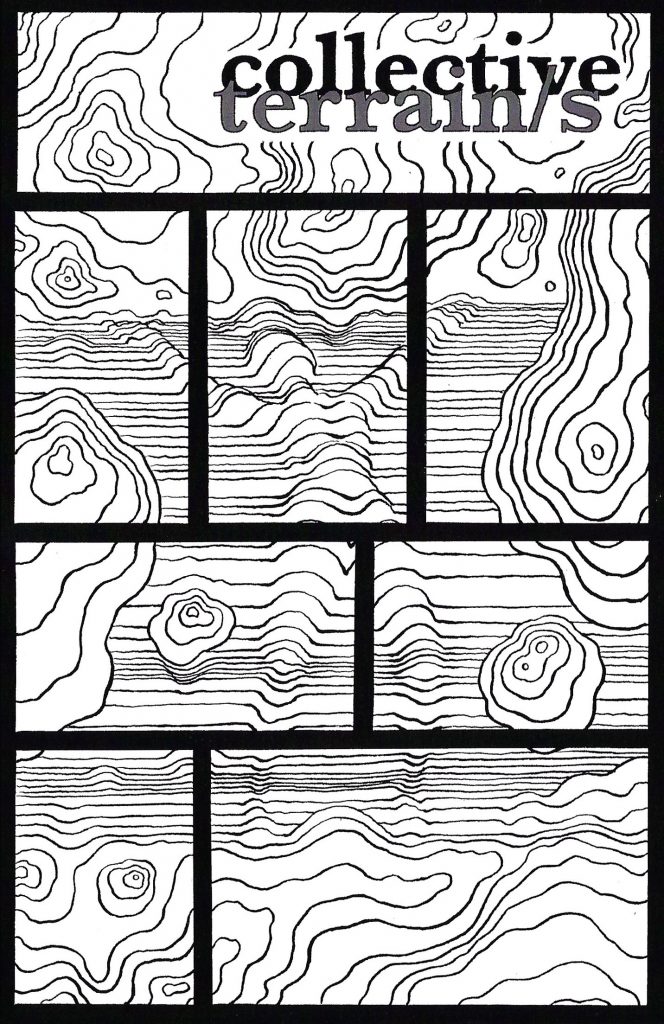Ways Of Gathering, Lydia Bell
April 16, 2020
This adapted piece of writing first appeared as an introduction to the collective terrain/s publication, edited by Lydia Bell, Jasmine Hearn, and Tatyana Tenenbaum and published by Danspace Project in April 2019. The year-long collective terrain/s project organized by Bell, Hearn, and Tenenbaum, was an antecedent project to the Platform 2020 Voice & Body research group.
When I witness an artist make work for Danspace Project, my vantage point is on the perimeter. I have conversations with the artist about the work’s content or logistics. I might sit in on a rehearsal or interview them or share a meal. But primarily I see it as my role to think about everything that happens around the work—how people enter the space of the work—literally and figuratively. I try, as an organizer, to consider the contents of the work’s exterior. To think about the edges; the edges of the work and the edges of the institution. Where do they meet? Where do they collide? (And where am I located as an individual in that collision?) Sometimes the best thing I can do is get out of the way. And sometimes my role is something murkier—to be present—but present in a way that is tuned to the vibrations of the artist and their work.
Jasmine Hearn and Tatyana Tenenbaum are artists who have made me think deeply about these questions of perimeter, presence, and vibration. I see both of them as artists who are engaged in the art of gathering, or perhaps—borrowing Amber Jamilla Musser’s evocative phrase from her essay on Samita Sinha’s work—they are engaged in the art of “flesh in formation” [1]. When I asked Jasmine and Tatyana to co-organize the collective terrain/s project with me, it was because I knew they were already engaged in thinking about the ethics of how we gather, how we are heard, and how we listen. I was curious about what would happen if those acts were fore-fronted in relation to their work.
And so we gathered. Jasmine and Tatyana invited Tendayi Kuumba and Samita Sinha to join the project and the four of them developed what they called “Words and Dreams for Our Collective Practice,” out of which the title of the project was born. In December 2018, the five of us, along with their networks of collaborators, gathered in the Sanctuary of Danspace Project for a week-long research residency. Each of the four artists invited a writer as a witness to their working practice, whose offerings are included in this publication: Amber Jamilla Musser, Nicole Wallace, Cyrah Ward, and Rochelle Jamila Wilbun. Denise Shu Mei, the designer of this publication, was also present. Rachel Cooper, Okwui Okpokwasili, Charmaine Warren, and Eva Yaa Asantewaa were invited witnesses and participants in rehearsals and conversations.
On the last day of the residency, the day after the winter solstice, around 50 people—primarily friends and family of the artists and their collaborators—gathered for an informal showing. I noticed that my voice was trembling as I gave a Land Acknowledgement and welcomed people to the space. It surprised me—I remember thinking that it was a week in which I felt grounded, in part by the vocal exercises I had participated in. But it also allowed me to question the negative associations I had with a trembling voice; my hyper-sensitivity to fragility in the voice as an indication of uncertainty in the body.
Perhaps this is what Okwui was getting at in a conversation after viewing rehearsals of Jasmine and Tatyana’s work: “I’ve been thinking about sound a lot—or even the idea of sound as a kind of archive, a cultural archive in the body. And all of the things that are part of that sound; the groan, the cry, the laugh…the whisper, the breath, the kind of sound in the breath”[2]. What if we thought of a tremble as an indicator of vulnerability, a reaching out across the border of self? What are those sounds or qualities of voice that exist beyond language, and what are their functions? I also think of something Jasmine said at another point in the week: “We all have our personal truths and we will never understand where each person comes from, really, ever” [3]. I remember Jasmine’s voice as she said this—a hint of a tremble but one that felt powerful, like it came from somewhere deep and true inside her. The possibilities of collectivity and yet simultaneously the limits. How we tend to that border.
Materially, Jasmine, Tatyana, Tendayi, and Samita are all working with (among other things) the relationship between voice and the body. And yet December’s conversations took us to so many different terrains: Houston, intergenerational trauma, the New York City subway, galaxies, hotel lobbies, the mountains of Colombia. The publication we’ve put together is an associative map to those terrains, perhaps “a map to go to places that [we] don’t know,”[4] as Samita says in speaking about her own work.
In spring 2019 we will gather again for public performances by Jasmine, Tatyana, Tendayi, Samita, and their collaborators in a series of shared evenings. By seeing their works next to one another, I hope to consider how private acts of gathering, sounding, and listening can reverberate in the public space of performance. I offer deep gratitude to Jasmine, Tatyana, Tendayi, Samita, and their collaborators for their explorations into voice and the body and their openness to an experimental process. I also offer deep gratitude to Judy Hussie-Taylor and Danspace Project staff, board, and funders for the space and resources to gather. And finally, I offer deep gratitude for those who have gathered before us—ancestors, activists, listeners, tremblers, dreamers. Thank you.
